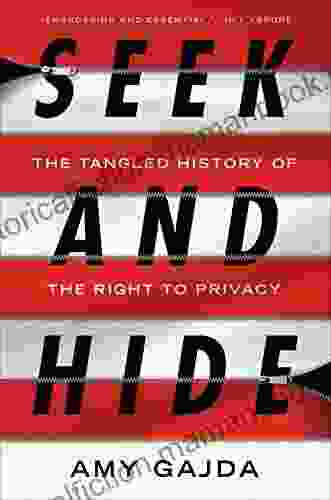The Tangled History of the Right to Privacy: A Comprehensive Examination

4.8 out of 5
| Language | : | English |
| File size | : | 2311 KB |
| Text-to-Speech | : | Enabled |
| Screen Reader | : | Supported |
| Enhanced typesetting | : | Enabled |
| Word Wise | : | Enabled |
| Print length | : | 399 pages |
The right to privacy is a fundamental human right that has been recognized in various forms and contexts throughout history. This article provides a comprehensive examination of the tangled history of the right to privacy, tracing its origins, evolution, and current legal implications.
Origins of Privacy
The concept of privacy has its roots in ancient civilizations. In ancient Greece, philosophers such as Aristotle and Plato discussed the importance of personal space and the need for individuals to have control over their own lives. Similarly, in ancient Rome, the concept of "domus" (home) was considered sacred and inviolable.
During the Middle Ages, the right to privacy was largely overshadowed by the influence of religious institutions and monarchies. However, the Renaissance period witnessed a renewed interest in individual rights and a shift towards a more secular view of the world. This shift contributed to the development of new legal theories and concepts that would later form the basis of the modern right to privacy.
Birth of Legal Protections
The 17th and 18th centuries saw the emergence of significant legal developments that laid the foundation for the legal protection of privacy. In 1641, the English Parliament passed the Habeas Corpus Act, which protected individuals from arbitrary arrest and detention. This act established the principle that the government could not infringe upon individual liberty without due process of law.
In the 18th century, the concept of the "right to be let alone" was articulated by legal scholars such as Samuel Warren and Louis Brandeis. In their influential 1890 article, "The Right to Privacy," Warren and Brandeis argued that individuals have a fundamental right to be free from unwarranted interference in their personal lives.
Constitutional Foundations
In the United States, the right to privacy was gradually recognized through a series of Supreme Court decisions. The Fourth Amendment to the U.S. Constitution, adopted in 1791, protects individuals from unreasonable searches and seizures. In the 1940s and 1950s, the Supreme Court ruled in cases such as Griswold v. Connecticut (1965) and Roe v. Wade (1973) that the right to privacy encompasses a broad range of personal decisions, including those related to marriage, reproduction, and bodily integrity.
In 1975, the U.S. Supreme Court ruled in the landmark case of Whalen v. Roe that the government's interest in collecting and using personal data for statistical purposes must be balanced against the individual's right to privacy. This ruling established a precedent for future legal challenges to government surveillance and data collection practices.
Technological Advancements
The advent of new technologies in the 20th and 21st centuries has posed significant challenges to the right to privacy. The development of computers, the internet, and social media platforms has led to an unprecedented explosion of personal data collection and processing. This has raised concerns about the potential for governments and corporations to misuse personal information for surveillance, marketing, and other purposes.
In response to these challenges, privacy advocates have called for stronger legal protections and increased transparency in the use of personal data. Governments around the world have enacted privacy laws and regulations, such as the European Union's General Data Protection Regulation (GDPR),to protect individuals' privacy rights in the digital age.
Current Legal Implications
The right to privacy remains a complex and evolving issue in the 21st century. Governments and corporations continue to collect and process vast amounts of personal data, raising concerns about the potential for privacy侵犯和滥用. At the same time, individuals are becoming increasingly aware of their privacy rights and are demanding greater control over their personal information.
Current legal implications of the right to privacy include:
- The Fourth Amendment to the U.S. Constitution protects individuals from unreasonable searches and seizures, including digital searches.
- The GDPR and other privacy laws and regulations impose restrictions on the collection, processing, and use of personal data by businesses and organizations.
- Individuals have the right to access, correct, and delete their personal data, as well as the right to object to the processing of their data.
- Governments have a duty to protect the privacy of their citizens and to balance the need for public safety with the right to privacy.
Balancing Rights and Interests
Striking a balance between the right to privacy and other societal interests is an ongoing challenge. Governments must ensure that privacy protections do not impede legitimate law enforcement and national security efforts. Similarly, businesses must balance their commercial interests with the privacy rights of their customers.
Ultimately, the right to privacy is essential for individual autonomy, dignity, and the free expression of one's thoughts and beliefs. As technology continues to evolve and the world becomes increasingly interconnected, it is more important than ever to protect and preserve this fundamental human right.
The history of the right to privacy is a complex and fascinating journey that spans centuries. From its ancient roots to its modern legal implications, the right to privacy has been shaped by philosophical, social, and technological factors. Today, the right to privacy remains a vital human right that is essential for individual freedom and the well-being of society.
As we navigate the challenges of the digital age, it is crucial that we continue to uphold and strengthen the right to privacy. By balancing the need for privacy with other legitimate interests, we can create a society that both protects individual rights and fosters innovation and progress.
4.8 out of 5
| Language | : | English |
| File size | : | 2311 KB |
| Text-to-Speech | : | Enabled |
| Screen Reader | : | Supported |
| Enhanced typesetting | : | Enabled |
| Word Wise | : | Enabled |
| Print length | : | 399 pages |
Do you want to contribute by writing guest posts on this blog?
Please contact us and send us a resume of previous articles that you have written.
 Top Book
Top Book Novel
Novel Fiction
Fiction Nonfiction
Nonfiction Literature
Literature Paperback
Paperback Hardcover
Hardcover E-book
E-book Audiobook
Audiobook Bestseller
Bestseller Classic
Classic Mystery
Mystery Thriller
Thriller Romance
Romance Fantasy
Fantasy Science Fiction
Science Fiction Biography
Biography Memoir
Memoir Autobiography
Autobiography Poetry
Poetry Drama
Drama Historical Fiction
Historical Fiction Self-help
Self-help Young Adult
Young Adult Childrens Books
Childrens Books Graphic Novel
Graphic Novel Anthology
Anthology Series
Series Encyclopedia
Encyclopedia Reference
Reference Guidebook
Guidebook Textbook
Textbook Workbook
Workbook Journal
Journal Diary
Diary Manuscript
Manuscript Folio
Folio Pulp Fiction
Pulp Fiction Short Stories
Short Stories Fairy Tales
Fairy Tales Fables
Fables Mythology
Mythology Philosophy
Philosophy Religion
Religion Spirituality
Spirituality Essays
Essays Critique
Critique Commentary
Commentary Glossary
Glossary Bibliography
Bibliography Index
Index Table of Contents
Table of Contents Preface
Preface Introduction
Introduction Foreword
Foreword Afterword
Afterword Appendices
Appendices Annotations
Annotations Footnotes
Footnotes Epilogue
Epilogue Prologue
Prologue Amir Heydari
Amir Heydari Avery North
Avery North Jack Hardin
Jack Hardin Wayne Caldwell
Wayne Caldwell Cyprian Norwid
Cyprian Norwid Brigitte Goldstein
Brigitte Goldstein Richard Dufour
Richard Dufour Robert J Bannon
Robert J Bannon Elizabeth Williamson
Elizabeth Williamson Jeff John
Jeff John Gregory David Roberts
Gregory David Roberts Theophilus Monroe
Theophilus Monroe Heidi Bond
Heidi Bond Isaac Asimov
Isaac Asimov Patricia Romanowski Bashe
Patricia Romanowski Bashe Johann Wolfgang Von Goethe
Johann Wolfgang Von Goethe Yuri Slezkine
Yuri Slezkine Xiao Yan
Xiao Yan Maurice Betz
Maurice Betz Ashley Hutchison
Ashley Hutchison
Light bulbAdvertise smarter! Our strategic ad space ensures maximum exposure. Reserve your spot today!

 Seth HayesModifying Schoolwork Third Edition Teachers Guides: A Comprehensive Guide for...
Seth HayesModifying Schoolwork Third Edition Teachers Guides: A Comprehensive Guide for... Wesley ReedFollow ·7.6k
Wesley ReedFollow ·7.6k Jackson HayesFollow ·18.3k
Jackson HayesFollow ·18.3k Billy FosterFollow ·2.5k
Billy FosterFollow ·2.5k Hugo CoxFollow ·18.3k
Hugo CoxFollow ·18.3k Greg CoxFollow ·5.9k
Greg CoxFollow ·5.9k Mikhail BulgakovFollow ·7.1k
Mikhail BulgakovFollow ·7.1k Victor HugoFollow ·16.2k
Victor HugoFollow ·16.2k Italo CalvinoFollow ·6.3k
Italo CalvinoFollow ·6.3k

 Allen Ginsberg
Allen GinsbergUnlocking Financial Peace with Low Risk Investing: A...
In the world of investing, it is often said...

 Eddie Powell
Eddie PowellLoop of Jade: An Exploration of Grief, Memory, and the...
Sarah Howe's...

 Zachary Cox
Zachary CoxHealth Benefits in Retirement: Navigating the Maze of...
Retirement...
4.8 out of 5
| Language | : | English |
| File size | : | 2311 KB |
| Text-to-Speech | : | Enabled |
| Screen Reader | : | Supported |
| Enhanced typesetting | : | Enabled |
| Word Wise | : | Enabled |
| Print length | : | 399 pages |















